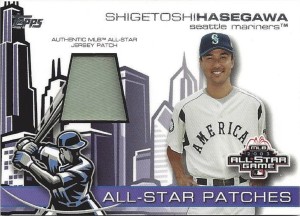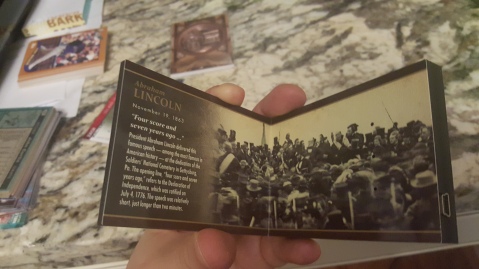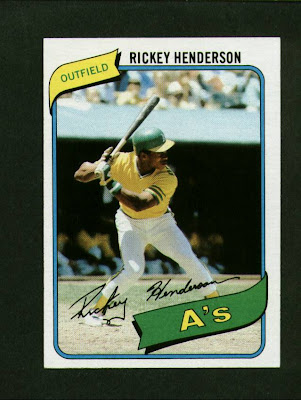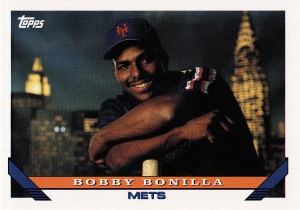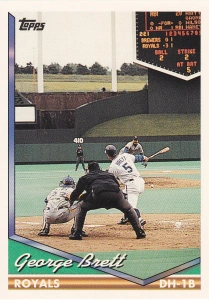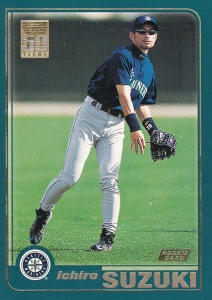There was a fairly notable rookie card in 2004 – Yadier Molina from the Cardinals. But there were 2 guys who were more notable in their absence. Barry Bonds, who was in the midst of 4 straight MVP awards, opted out of the MLBPA deal with card companies early in 2004. So he was in far fewer card sets in 2004. He eventually signed an exclusive deal with Topps at the end of the year, and was featured in 2005 Topps.
And Rickey Henderson was not in the regular Topps product for the first time since his 1980 rookie card. One of the things I always show in these posts was a picture of my two favorite players – Rickey Henderson and of Ken Griffey, Jr. So here’s Griffey, all by his lonesome.

And here’s that Molina card.

Jim Thome got the nod with card #1, after leading the NL in homers in his first season in the senior circuit. Sammy Sosa got the first card of the 2nd series.

A few other groupings I show every year – here are the big 3 shortstops who put their stamp on baseball from the mid-90’s on. This would be Nomar’s last Topps card with the Red Sox.

Jeter and A-Rod were on the same card later in that set. Topps did 3 combo cards in series 2, one of which was showing the press conference for when Rodriguez was traded to the Yankees. Personally, I’d take the card with Mike Schmidt and Thome.

And here’s Maddux, Glavine and Smoltz. Maddux had a retro uniform on, while Smoltz had the same uniform for his 2003 Topps card. Glavine just always looked strange in a Mets uniform.
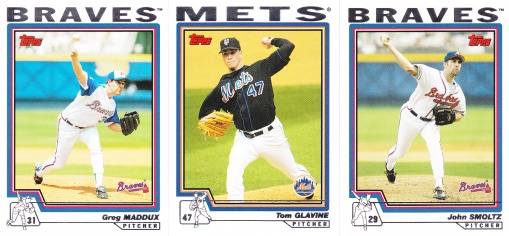
Here was another big 3 pitchers, though they obviously didn’t turn out as well as the 3 guys above. It was pretty cool, though, when Zito and Hudson pitched against each other in late September to end their careers.

Last of these trios are the killer B’s. By this point, Berkman had become Houston’s best player, and Bagwell was really near the end of his career.

I always like the Season Highlights subset, and there were 5 cards in this subset in 2004. There was quite a bit of history in this subset – a pretty unique season. Two players reached the 500 homer plateau, Roger Clements got his 4,000th strikeout in the same game as his 300th victory, and Eric Gagne set the record by converting his 55th straight save. Oh, and Kevin Millwood threw a no-hitter. OK, so most of them are pretty unique.

Moving on from those cards, here are some of the photos I liked. I noticed a bunch of cards that had the American Flag on the wall in the background. When I flipped back through the set, I found 6, though there could be more.

OK, so from there – I’ve got to say, I love this set. The silhouette, circle figure or whatever you want to call that thing in the bottom left? I think it’s a phenomenal addition, and I would love for it to be on some other cards. It does a few things. First, it forces the photo to be back a bit, so that most of the player’s form is in the picture. In a lot of cases, like the Raul Ibanez card above, Topps goes too extreme with this.

But It’s cool to see the image and then compare it to the colorless drawing. For any action shots, it makes me appreciate what is going on in the play featured. It could be a rundown, a race to home after a wild pitch, the aftermath of a pop-up chased by 2 fielders, or breaking up a double play. But the little stick guy makes those plays stand out on this card more than any other set.

It’s a unique design element that isn’t really on any other card set. Yes, it harkens to 1976 Topps, but those figures weren’t unique to each card. The catchers had the same logo, the pitchers had the same logo, etc. On a lot of the cards, you could probably guess the player in question just from the little white figure. Like Hideo Nomo in his windup. Or submariner Chad Bradford and Byung-hyun Kim…

…Marquis Grissom’s batting stance, Alfonso Soriano’s bat flip, Jason Giambi’s follow-through…

I always thought Brandon Phillips had a very distinct plant and throw to first, it’s captured well here. Posada is getting after it in his catching gear. And of course, Adam Dunn directing traffic. He always seemed like one of those “delegators”.

The design also lends itself very well to horizontal designs. These are some of the best cards in the whole set. Jason Kendall likes horizontal designs.

Here’s a few more great action shots, but in the vertical format.

And a final group of cards that I picked because I like the picture. These are more pose, or at least not a ton of action. I thought the Scioscia card was weird – putting a 2002 World Series trophy in the 2004 set was odd. I think it may have been a celebration early in the 2003 season in front of the Anaheim home fans.

Of course, series 2 showed a lot of guys in new uniforms. Here are the biggest names. Clemens made headlines because he had gone through the whole retirement thing the year before. Then he was “coaxed” out of retirement by the Astros. Vlad Guerrero was probably the biggest signing – he would add an MVP to his mantle in his first year in Anaheim. Just like Reggie Jackson had done 28 years earlier, Miguel Tejada took the MVP he already had from Oakland to Baltimore. A few years down the line, he would be in the middle of lidocaine and B-12 controversy with the other free agent to come to Baltimore that year. Pudge Rodriguez was one-and-done in Florida, but he helped the Marlins to a World Series in that one year. And Kevin Brown, well the most interesting thing I can say about his tenure in New York has to do with who he was traded for. The Yankees shipped Brandon Weeden to LA. That was 12 years ago; last month, Weeden was busy starting at quarterback for the most valuable franchise in sports.

Then there’s always a few guys with new uniforms where I always say “he played for them?”

As I mentioned, Yadier Molina had the only notable rookie card in the set. There were quite a few guys from prospect cards who had great careers, and other guys who were rookies in the 2003 season.

Moving up to guys who had a little more experience (but not much) – these guys were just starting to show their promise.


Moving up the ladder, these guys were all-stars on their way to being some of the best in the game.

The next cards were players who, regardless of their age, were the best in baseball at this point.


These guys were nearing the end of their career, but still had a little left in the tank.

Finally, here’s the guys who were really near the end of their careers.

These scanning posts are always my longest, and this one seems to have been longer than usual. Thanks for reading!











